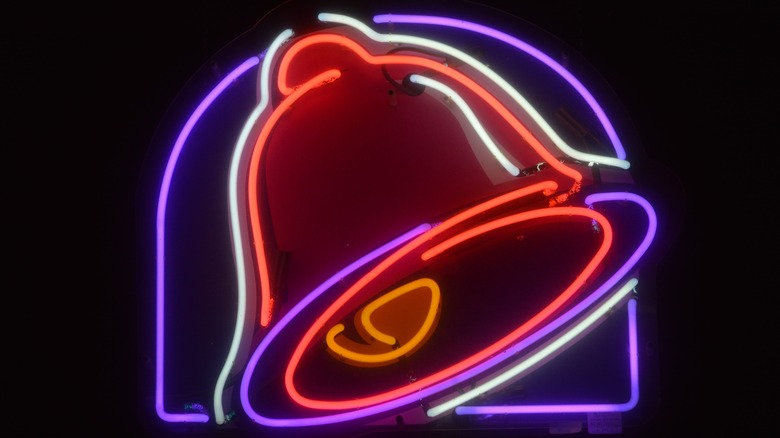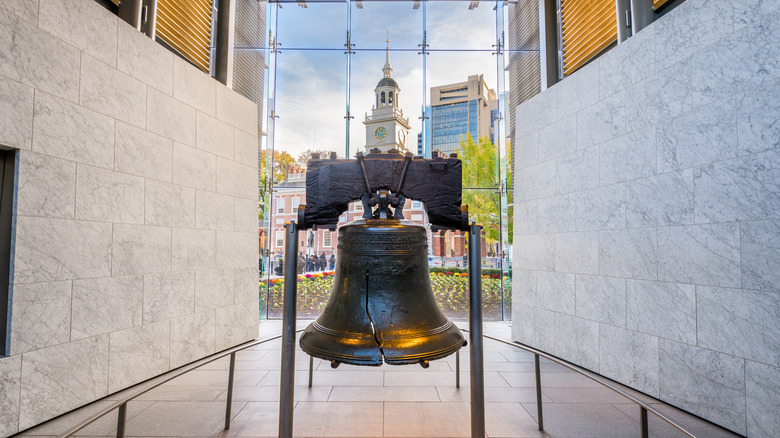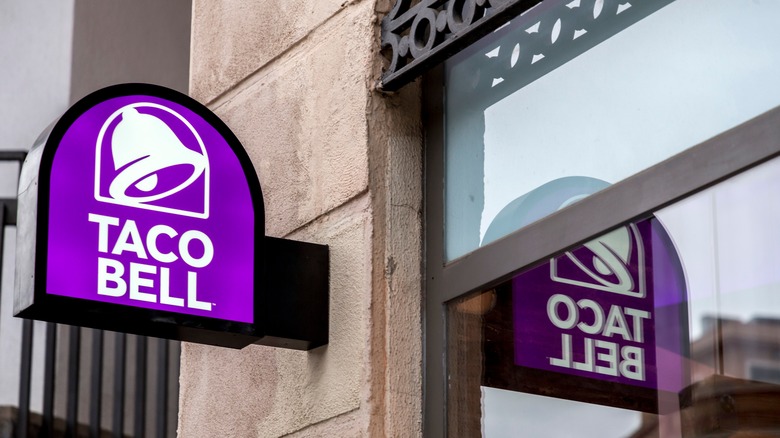Did Taco Bell Really Buy The Liberty Bell At One Point?
For one reason or another, Taco Bell always seems to be in the news. From rat-poisoned bean burritos to a closed restaurant's candlelit vigil, the Tex-Mex chain is often associated with a nuance of ludicrous statements and situations. Understandably, some of the famous restaurant's biggest publicity comes from abrupt menu changes.
According to chief brand officer Sean Tresvant through CNN, the business even reportedly "over-innovated" breakfast items in 2022, such as the Naked Egg Taco and the Waffle Taco. Fortunately, these were taken off the menu shortly after their release. One Twitter user named @Drift0r commented, "I ate the waffle taco. Something isn't settling right. Actually feeling queasy now. Never again." The company soon hired Pete Davidson as a "Taco Bell Brand Apologist" to formally atone for their crimes against breakfast foods. But as absurd as these reports sound, nothing is as outlandish as when Taco Bell announced its intentions to buy the Liberty Bell in 1996.
The '90s were a time of commercialized real estate. Stadiums like Coors Field in Colorado were frequently bought and named after corporations to sponsor brands and promote company sales. Mental Floss reports Taco Bell was similarly looking for marketing outlets but couldn't find a campaign opportunity to effectively boost the brand. Instead, they wanted to stand out and do something that would be remembered for decades. Luckily, just before April 1996 came around, David Paine (PR firm owner) and Jonathan Blum (marketing executive) became aware of a certain approaching day. They viewed it as the perfect gateway to execute their plan and set this idea into motion.
The 'Taco Liberty Bell'
Within days, Taco Bell's decision to 'buy' the Liberty Bell could be read in national news outlets like the New York Times, the Washington Post, and USA Today. The article, released on April 1, 1996, stated, "In an effort to help the national debt, Taco Bell is pleased to announce that we have agreed to purchase the Liberty Bell, one of our country's most historic treasures. It will now be called the 'Taco Liberty Bell' and will still be accessible to the American public for viewing" (via Way Back Machine).
While most correctly wrote this announcement off as a hoax – mainly since it fell on April Fool's Day – others overlooked the comical date. Chaos shortly ensued. According to the Philadelphia Inquirer, consumers found no humor in Taco Bell's prank, especially when the company reported that the Liberty Bell would be temporarily relocated to Irvine, California. Mental Floss says that angry citizens across the country made numerous calls to the National Park Service and Taco Bell's headquarters, berating the company's intentions of buying a historic symbol of American freedom.
But this running joke didn't last long. Within a few hours, Taco Bell released another statement revealing the truth of their harmless hoax. Even Michael McCurry, then serving as White House press secretary for the Clinton administration, joked and teased about the future commercialization of other iconic American figures, per Washington Post. In the end, Taco Bell pledged $50,000 to preserve the Liberty Bell and promised to keep it at Independence National Historical Park.
Did Taco Bell design its logo after the Liberty Bell?
Outside the Crunchwrap Supreme, Taco Bell can be solely identified by its logo. It first appeared in 1985 as a yellow and green bell, noticeably sharing a similar structure as the historic Liberty Bell (per 1000logos). Before that, a colorful jumble of letters illustrated the company's name. But once the 1996 prank went viral, some began to wonder if the two bells' association actually extended beyond the hoax.
Taco Bell's name and logo are inspired by Glen Bell, the creative mastermind behind the chain. According to the company's website, Bell started his food-business journey in California in 1948 with Bell's Hamburgers. But in 1954, Bell began to 'think outside the bun' (a motto later popularized in 2002) and created Taco Tia, Taco Bell's predecessor. The world's first Taco Bell opened eight years later and has since become an international sensation, serving close to 1/4 of the global population annually. It also created one of the world's largest — and most sincere — pranks ever initiated by a fast food chain.
According to the Chicago Tribune, the comical campaign's original cost was $300,000. But when the ad became a national rumor, it produced nearly $25 million in free publicity. It also caused the chain's sales to rocket by $1.1 million within two days. So, while the Bell's bell isn't inscribed to "Proclaim [Tacos] Throughout All the Land Unto All the Inhabitants thereof," it did promise to Live Más.


